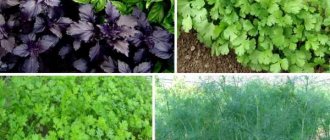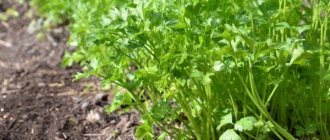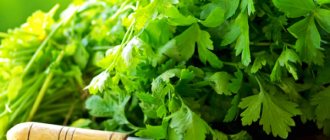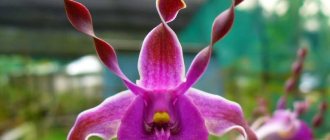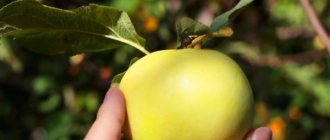Features of root parsley
This plant belongs to the Celery family. Root parsley belongs to the subspecies of curly parsley. The appearance of the plant can be seen in the photo.
The development cycle of root parsley is 2 years. During this time, the plant reaches a height of 1 m. The green part of the plant is a rosette of erect green branches. They are covered with shiny dark green leaves in the shape of a triangle. The fruits of root parsley are longitudinally ovoid in shape. The underground part is a developed root crop. It is often used for culinary purposes as a seasoning.
Growing root varieties of parsley is very similar to cultivating a regular spice. The main differences are as follows:
- Due to the presence of rhizomes, such varieties are planted immediately in a permanent place. They do not tolerate transplantation.
- Root parsley seeds are not soaked. This procedure deprives the seeds of a significant portion of calcium. Therefore, young parsley grows weak.
On a note!
For quick and friendly emergence of seedlings, it is recommended to keep the selected seeds in hot water for half an hour. Then they need to be dried and sowed. Today, retail outlets for gardeners and gardeners have a large assortment of root parsley seed material. More often than others, buyers are interested in the following varieties:
- Sugar root parsley, when grown, produces root vegetables weighing up to 75 g. This is one of the oldest varieties. He was taken out back in 1950. After the sprouts appear, this variety ripens within three months. The disadvantage of this variety is its short shelf life.
- The Alba variety is a late-ripening variety. It ripens within 170 days after sprouting. Alba is especially popular among summer residents for the large size of its root crops, the weight of which reaches 230 grams. The plant forms a strong spreading bush and produces up to 5 kg of long-lasting root crops per square meter of land.
- The variety "Urozhainy" is a mid-season variety. Its ripening period from the moment of emergence of seedlings is 130 days. The plant forms lush, spreading bushes with fragrant greenery. The fruits of this variety grow weighing up to 120 grams. They are delicious raw or cooked and keep well for several months. From one square meter you can get up to 3.5 kg of root vegetables.
Composition of the root and its beneficial properties
The nutritional value and chemical composition of 100 g of root in comparison with greens is shown in the table:
| Root | Parsley | |
| Calorie content | 51 | 49 |
| Proteins, g | 1,5 | 3,7 |
| Fats, g | 0,6 | 0,4 |
| Carbohydrates, g | 10,1 | 7,6 |
| Dietary fiber, g | 3,2 | 2,1 |
| Water, g | 83 | 85 |
| Organic acids, g | 0,1 | 0,1 |
| Ash | 1,1 | |
| β-carotene, mg | 0,01 | 5,7 |
| Vitamin B1, mg | 0,08 | 0,05 |
| Riboflavin (B2), mg | 0,1 | 0,05 |
| Choline (B4), mg | 7,7 | 12,8 |
| Pantothenate (B5), mg | 0,4 | 0,05 |
| Pyridoxine (B6), mg | 0,6 | 0,18 |
| Folates (B9), mcg | 24 | 110 |
| Vitamin C (main water-soluble blood antioxidant), mg | 35 | 150 |
| Vitamin E, mg | 0,1 | 1,8 |
| Biotin (vitamin H), mcg | 0,4 | |
| Phylloquinone (vitamin K), mcg | 164 | 1640 |
| Vitamin PP, mg | 1,3 | 1,6 |
| Macronutrients | ||
| Potassium, mg | 342 | 800 |
| Calcium, mg | 57 | 245 |
| Silicon, mg | 13 | 15 |
| Magnesium, mg | 22 | 85 |
| Sodium, mg | 8 | 34 |
| Sulfur, mg | 22,3 | 29,7 |
| Phosphorus, mg | 73 | 95 |
| Chlorine, mg | 18,8 | 160 |
| Microelements | ||
| Aluminum, µg | 97,4 | 425 |
| Boron, µg | 41 | 75 |
| Vanadium, mcg | 10 | 24,5 |
| Iron, mcg | 0,7 | 1,9 |
| Lithium, mcg | 2,8 | 21 |
| Copper, µg | 220 | 149 |
| Molybdenum, mcg | 2,9 | 5,6 |
| Nickel, µg | 11,1 | 10 |
| Rubidium, mcg | 14,2 | 41,5 |
| Selenium, mcg | 0,1 | 0,1 |
| Strontium, mcg | 22,2 | |
| Fluorine, mcg | 110 | 230 |
| Digestible carbohydrates | ||
| Starch and its derivatives, g | 4 | 1,2 |
| Sugar, g | 6,1 | 6,4 |
| Fatty acid | ||
| Omega-3, g | 0,042 | 0,008 |
| Omega-6, g | 0,283 | 0,115 |
| Saturated fatty acids, g | 0,2 | 0,1 |
As we can see from the table, the root vegetable contains less vitamins than the leaf part of the plant. However, 73 g of grated root will replace the daily requirement of vitamin K, two roots (250 g) will restore the supply of vitamin C.
All parts of the plant contain essential oil. In seeds its volume reaches 7%, in root vegetables – up to 0.1 g per 100 g of product. Its constituents include apiol, myristicin, pinene, and limonene, which give the plant a specific odor.
White root is widely used
Application
Parsley is usually used as a seasoning for culinary dishes. It is added:
- side dishes;
- fish and meat dishes;
- first meal.
Chopped rhizomes and greens are used to prepare stews and many sauces. Sometimes parsley is fried or eaten baked, but more often it is added raw to prepared dishes.
This plant contains oil esters, flavonoids, pectin and other beneficial substances. When consumed regularly, parsley normalizes the functioning of the gastrointestinal tract, improves the body's immune defense, prevents the formation of kidney stones, and relieves problems with gums. Cosmetic masks are often made from parsley to treat acne and eliminate oily skin.
Although this plant provides many benefits, it is not suitable for everyone. Parsley is harmful to the health of pregnant women. Parsley juice should not be drunk by people suffering from cystitis or neuritis.
Uses of parsley root
For medicinal purposes, the root vegetable is used raw or dried. In this case, it is possible to combine parsley with other medicinal plants.
To treat gout, use a decoction in which the root vegetable is combined with birch leaves, nettles and violets. The finished drink is consumed three times a day before main meals, 100 ml.
Ingredients:
- 1 part nettle leaves;
- 1 part birch leaves;
- 1 part violet flowers;
- 1 part chopped parsley root;
- 250 ml water.
How to cook:
The plant ingredients are mixed together and placed in a glass jar with a lid. Separate 1 tbsp from the total mass. l. mixture and fill with water. Bring the mixture to a boil over low heat and boil for 10 minutes. Then cover the dish with a lid and leave for 30 minutes.
To treat chronic cystitis, use a decoction of 2 large root vegetables and 1.5 liters of water. Plant materials are crushed and boiled for 30 minutes. Leave to brew for another 12 hours. Then take 200 ml in the morning on an empty stomach.
For prostatitis
To alleviate the condition of prostate inflammation, parsley is used in different forms: the juice is squeezed out of the root vegetable, a decoction is prepared, or it is included in a medicinal collection. Juice from the fresh root is consumed half a glass before breakfast for 2 weeks.
To prepare the infusion, fresh rhizome is crushed and poured with boiling water. After ten hours of infusion, filter and consume 100 ml three times a day.
Ingredients for preparing the collection:
- 1 part poplar buds;
- 1 part goldenrod;
- 1 part parsley rhizome;
- 1 part asparagus;
- 1 part motherwort;
- 1 part wheatgrass root;
- 750 ml water.
How to cook:
Plant materials are crushed and mixed. Separate 150 g from the total mass and pour boiled water over it. Cover the dish with a lid and leave for 12 hours. After straining, drink 2 tbsp. l. 6 times a day. The duration of the course is 1 month.
Cleansing the body
Using parsley infusion, cleaning is carried out in courses lasting 2 weeks. This procedure removes toxins, waste deposits from the body, and removes excess fluid. This procedure is very useful for vascular health. They are cleared of cholesterol deposits.
Ingredients:
- 150 g fresh parsley root;
- 500 ml water.
How to cook:
The root is grated and poured with boiled water. Cover the pan with a lid and leave for a quarter of an hour. After filtering, drink the infusion 4 tbsp. l. in a day.
Skin health
Externally, parsley root is used to improve the condition of the skin. It helps reduce oiliness, eliminates greasy shine and unnecessary pigmentation, and tightens pores. The product is used in the form of masks or homemade tonic.
To make the skin more elastic, improve its tone, get rid of oiliness and enlarged pores, use an infusion of hot milk. For it, mix 1 pinch each of rosemary, tarragon, sorrel and chopped parsley root. Pour boiled milk over everything and leave for 30 minutes. Then wipe the face with the milky liquid using a cotton swab.
To lighten freckles or age spots, crushed fresh root is mixed with 2 tbsp. l. curdled milk. The mask is applied to the face and left for 20 minutes.
To relieve PMS
Parsley calms the nervous system, normalizes the female cycle and relieves pain during menstruation. To do this, regularly take a decoction of parsley seeds.
Ingredients:
- 3 tbsp. l. parsley seeds;
- 1 glass of water.
How to cook:
Bring water to a boil and pour parsley seeds over it. Bring the mixture to a boil over low heat and boil for 15 minutes. After cooling, the broth is filtered and taken up to 7 times a day, 1 tbsp. l.
For prevention
Due to the fact that parsley root has many medicinal and beneficial properties, in the absence of contraindications it can be consumed every day. It is recommended to eat it fresh or as part of culinary dishes. This remedy prevents fluid stagnation in the body, protects against infectious diseases, normalizes digestion, and makes breathing fresher.
On a note!
It is useful to regularly drink tea with parsley and take baths with the decoction. The latter procedure is especially recommended for women with problem skin.
For weight loss
When properly prepared, a decoction based on parsley roots helps in weight loss. When cleansing the body, metabolic reactions are accelerated, toxins, salts and unnecessary fluid are eliminated. The root vegetable removes toxins from the liver and blood vessels, reduces appetite.
To reduce weight and speed up metabolism, the root vegetable is consumed fresh separately or included in a salad with other vegetables. You can prepare the decoction and consume it in different ways. The effect of using the decoction will only be if you change your diet and exercise.
Is it possible to plant parsley before winter?
Root parsley tolerates low temperatures well. In open ground, parsley seeds can be planted after the soil has warmed to +4 degrees. In practice, planting is carried out immediately after the snow melts and the soil thaws. Moreover, it is important not to miss the right time and sow the seeds when the soil is still filled with moisture. The seeds need it for germination. If the soil dries out, there will be no seedlings.
Important!
Cold-resistant root parsley is often sown before winter. This frees up time for other spring work. After winter, seeds germinate immediately after favorable conditions.
When planting in the fall, choose a time 15 days before frost sets in. This time is enough for the seeds to swell, but they will not have time to germinate. For pre-winter cultivation, seeds are placed in the ground only dry. In this case, the quantity is increased by a third.
How to choose a place
In order for the cultivation and care of root parsley to be successful, choose a suitable place to create a bed. This crop grows well in loose soil. Light loamy or turf-ash soils and sandy loam are better suited than others. Choose an area with good lighting. In a shaded area, parsley roots will grow small. Groundwater on the site should not come close. Otherwise, the parsley will rot.
Root crops feel better on the south side of buildings, protected from the north wind and draft. When planting seeds, it is important to consider the rules of crop rotation. The yield of this crop will be high if it is planted after zucchini, cucumbers or pumpkins. Umbrella plants, such as carrots or celery, reduce yields.
The parsley bed is prepared in advance. If the seeds are planted in the spring, then preparation is carried out in the fall. During pre-winter planting, preparatory work is carried out a month in advance.
May strengthen your immune system
Parsley root is an excellent source of fiber and vitamin C, two nutrients that are vital for a healthy immune system.
A 100-gram serving of raw parsley root contains more than half the RDA for vitamin C and nearly 20% of the RDA for fiber (2).
Vitamin C is essential for a healthy immune system as it fights foreign bacteria, stress and inflammation. Moreover, it helps the tissues of the skin and digestive tract become a strong barrier against bacteria and other harmful substances (14).
Meanwhile, fiber supports the growth of healthy bacteria in the digestive tract. Research shows that healthy gut flora protects against infection (15).
Summary:
Parsley root is an excellent source of vitamin C and fiber, two nutrients essential for a healthy immune system.
Growing in open ground
To prevent root vegetables from becoming coarse, do not add humus to the ground before planting root parsley. It is also prohibited to enrich the soil with compost. Only mineral complexes are used as fertilizer, adding them according to the instructions. Fertilizer is applied while digging the area on the bayonet of the shovel. At the same time, the area is cleared of weeds.
The rows are marked at intervals of 20 cm in the form of furrows 2 cm deep. During spring planting, the bed is watered with a heated solution of potassium humate, which accelerates seed germination. They are planted at intervals of 3 cm from each other, 3 pieces together. Then the furrow is covered with soil and compacted. To keep the soil moist longer, cover the bed with any covering material. Seeds take a long time to germinate. Therefore, the plantings are regularly irrigated without removing the cover. When shoots appear, all weak plants are removed, leaving the strongest of the group.
Planting and care at home
Root varieties of parsley are suitable for producing greens in winter. To obtain a good harvest, before seed germination, the boxes are kept at a temperature of +4 to +10 degrees. After this, the temperature is raised to +15 degrees.
The soil is regularly irrigated, but without overwatering. Root parsley does not tolerate high humidity and rots quickly. Parsley does not have enough daylight hours to grow in winter. Therefore, young plants are additionally illuminated with phytolamps. In total, parsley requires at least 16 hours of light.
The soil is enriched with fertilizers during sowing of seeds. If the plant looks weak and depressed, additional mineral complexes are added after cutting the greenery.
Important!
Forcing green mass from the rhizome often provokes the appearance of arrows.
Growing parsley in a greenhouse
Some summer residents practice growing root parsley in a greenhouse. Early ripening varieties are suitable for growing in shelter. During the winter they produce a good harvest if they are provided with suitable conditions and care. Then parsley produces a harvest while other crops are just about to be planted.
Typically, you need to plant parsley root in a greenhouse in January. If the weather gets too cold, the plantings are covered with lutrasil.
Possible harm and contraindications
Despite its usefulness, parsley root has a number of contraindications and can harm the body :
- Essential oils in the product can cause allergies and individual food intolerances.
- For diseases of the genitourinary system, parsley root products should be used carefully and under the supervision of a physician.
- Excessive consumption of parsley can lead to an excess of microelements and, accordingly, to a deterioration in well-being.
- If calcium metabolism disorders are observed in the body, the product should not be consumed.
- Parsley preparations are contraindicated for epilepsy, exacerbations of ulcers and gastritis of the stomach and attacks of urolithiasis.
- Parsley root is contraindicated during pregnancy as it stimulates the muscles of the uterus. This may lead to miscarriage.
Features of care
Parsley is not one of the capricious plants. Minimal care will be enough to grow a good harvest.
This plant can tolerate a short period of drought, but the water supply cannot be limited for too long. This spoils the taste of the plant. Irrigation is carried out immediately after the top layer of soil dries in the morning or evening. Heated water is used for irrigation. The liquid is poured into containers in advance and left to settle. During rain, it is better to cover the beds with parsley with film.
To properly care for parsley, fertilizing is required. Before planting, the soil is enriched with mineral complexes. When the first shoots hatch, apply nitrogen fertilizers from herbal infusion once:
- The roots of the weeds are torn off and the container is filled with the remaining green mass.
- Fill with water.
- Close the container and leave it in a sunny place.
- When signs of fermentation appear, filter the infusion and add 8 parts of water.
The prepared solution is used to water the beds with parsley. When the greenery grows 15 cm, soluble mineral complexes are added.
Parsley is a herb or vegetable
Many people who are far from botany, knowing what parsley looks like, consider it a herb, since it is most valued for its spicy, delicate greenery. It is in the form of bunches of twigs with leaves that it can most often be found in markets and stores.
Looks like a herb, but is actually a leafy vegetable.
But from a botanical point of view, it is a leaf vegetable, since in addition to the above-ground edible part, it also produces tasty, edible root vegetables. This applies to root species. By the way, you can also use their leaves. They are not as tender and flavorful as leaf parsley, but are still quite edible. Just cut them off before flowering and in small quantities to allow the root crops to develop normally. After the formation of peduncles begins, the leaves become hard.
Diseases and pests
All possible diseases in this crop arise due to improper care. Therefore, it is important to adhere to basic agricultural practices in order to get a good harvest. More often than others, root parsley is affected by:
You may be interested in: Parsley for women: benefits and harms, beneficial properties and contraindications Parsley root: medicinal properties and contraindications How to properly grow parsley in a greenhouse in winter
- pernosporosis manifests itself as spots on the leaves and drying out of the green part;
- white rot affects the roots, softens them;
- white spotting appears in the form of light spots on the leaves and their rotting;
- Rust appears as redness on the leaves and drying out of the tops.
Of the insects that bother root parsley most of all, the carrot psyllid. The pest lays its eggs at the base of the root crop. Then after hatching the larvae eat it. To protect plants from attack, they are dusted with wood ash and tobacco dust. In summer, cover the beds with loose lutrasil.
Another pest that attacks parsley is the aphid. Its distributor is ants. Therefore, in the spring, all anthills are destroyed. In summer, aphids are washed off with a solution of tar soap. It helps to get rid of aphids and carrot flies by planting garlic and onions between the rows.
How to collect and preserve the harvest
The period of digging up rhizomes begins in September. For greater preservation of root crops, it is recommended to use a pitchfork rather than a shovel. After digging, shake off the soil from the roots and leave to dry in the sun for 2 hours. This helps kill pathogenic bacteria.
Then they start cutting the tops. If you plan to use the root part for forcing greens in winter, leave a stump up to 2 cm high. If the root crop is sent for storage, the growth point is cut off along with some part of the root. So, it will retain more juiciness.
You can keep root vegetables in the refrigerator. To do this, they are placed in a plastic bag with holes. If possible, the roots are placed in a wooden box and sprinkled with moistened sand. In this form, the containers are lowered into the basement or cellar.
The taste and beneficial properties of root vegetables are well preserved after freezing. To do this, they are washed, dried and cut. In a bag or container, the cooked pieces are sent to the freezer.
